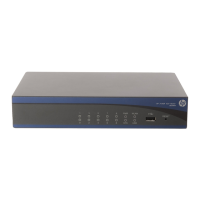For each channel set, the system automatically creates a serial interface numbered serial
interface-number:set-number. This interface has the same logical features as a standard synchronous
serial interface and supports the following configurations:
• Data link protocols, such as PPP and HDLC.
• IP addressing.
• Interface backup settings if the interface is used as a primary or backup interface.
• NAT and packet filtering if a firewall is to be set up.
Configuring a CE1/PRI interface in PRI mode
Step Command Remarks
1. Enter system view.
system-view N/A
2. Enter CE1/PRI interface view.
controller e1 number N/A
3. Configure the interface to
operate in CE1/PRI mode.
using ce1
The default operating mode is
CE1/PRI mode.
4. Bundle timeslots on the
interface into a PRI set.
pri-set [ timeslot-list list ]
By default, no PRI set is created.
The timeslots on a CE1/PRI
interface can be bundled into
either channel sets or a PRI set, but
not both at the same time.
5. (Optional.) Set other interface
parameters.
See "Configuring other CE1/PRI
interface parameters."
N/A
A CE1/PRI interface in CE1/PRI mode can operate as a PRI interface. You can create only one PRI set on
this type of interface.
For the PRI set, the system automatically creates a serial interface numbered serial interface-numbe:15 .
This interface has the same logical features as an ISDN PRI interface and supports the following
configurations:
• DDR.
• PPP and PPP authentication.
• IP addressing.
• Interface backup settings if the interface is used as a primary or backup interface.
• Firewall.
Configuring other CE1/PRI interface parameters
Step Command Remarks
1. Enter system view.
system-view N/A
2. Enter CE1/PRI interface view.
controller e1 number N/A
3. Configure the interface
description.
description text
By default, the description of an
interface is interface-name
Interface.
23

